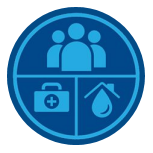
Public Water Supplies

Related Forms
Annual Water Quality Report Certification Form
Application for Approval of Backflow Prevention Devices
Application for Approval of Plans for Public Water Supply Improvement
Coliform Bacteria in Drinking Water Supplies
E. coli O157:H7 Infection Fact Sheet
Guidelines for Designing Backflow Prevention Assembly Installations
Report on Test and Maintenance of Backflow Prevention Device
Annual Water Quality Reports
2022 Fayette Water District #1, 2, 5, 6
2022 Fayette Water District #3 & #7
2022 Finger Lakes Mobile Home Park
2022 Junius Water District #1 & #2
2022 Seneca Lake Water District
2022 Seneca Falls Water District
2022 Town of Waterloo, Border City, Burgess Rd
2022 Willard Drug Treatment Center
2022 Seneca County Water District #1
Springtime/Snow Melt Off Poses Potential Health
Concerns With Localized Flood Waters
Wells and springs that were covered by flood waters, even temporarily, should be considered contaminated and not used for drinking. Contact the Seneca County Environmental Health Office for directions in disinfecting and testing your well water 315-539-1945.
Please contact the following to pick up bottles for water testing:
WATERLOO WATER TREATMENT PLANT
315-585-9811
WATERLOO TOWN OFFICES
315-539-9131
SENECA COUNTY HEALTH DEPARTMENT
315-539-1945
COMMUNITY SCIENCE LAB
607-257-6606
ROMULUS TOWN HALL
607-869-9326
Click here to learn more about Proper Well Disinfection Procedures
A public water system is a any entity which provides water to the public for human consumption through pipes or other constructed conveyances. In New York, any system with at least 5 service connections or that regularly serves an average of at least 25 people daily for at least 60 days out of the year is considered a public water system. Public water systems are categorized as one of the following types of systems: community and non-community (including non-transient non-community and transient non-community).
A community water system is a public water system that serves the same people year-round. Most residences including homes, apartments, and condominiums in cities, towns and mobile home parks are served by community water systems. Examples of community water systems include municipally-owned (cities, towns, or villages) public water supplies, public water authorities, or privately-owned water suppliers such as homeowner associations, apartment complexes, and mobile home parks that maintain their own drinking water system.
A non-community water system is a public water system that serves the public but does not generally serve the same people year-round. There are two types of non-community water systems transient and non-transient non-community water systems.
A transient non-community water system is a non-community water system that serves different people for more than six months out of the year. Rest stops, parks, convenience stores and restaurants with their own water supplies are examples of transient non-community water system.
A non-transient non-community water system is a non-community water system that serves the same people more than six months per year, but not year-round. Schools, colleges, hospitals and factories with their own water supplies are examples of non-transient non-community water system.
A ground water source is a source of water that is taken from beneath the earth’s surface, usually in an aquifer, which is a natural underground layer, often of sand or gravel, which contains water. Most public water systems with groundwater sources pump and treat groundwater from wells, which are drilled into the ground to capture water flowing below surface level.
A surface water source is a source of water that is open to the atmosphere and subject to surface runoff. Examples of surface water sources include lakes, rivers, and reservoirs.
A ground water source under the direct influence of surface water is defined as any water beneath the surface of the ground that when tested, has physical characteristics (such as turbidity, temperature, conductivity, or pH) that closely correlate with surface water chemistry; and/or well water that rises in temperature soon after precipitation events; and/or ground water that is found to contain microorganisms or debris that are typically found only in surface water such as algae, organic debris, large-diameter pathogens, or insects.
Thirty-six counties and New York City Health Department have direct oversight of the public drinking water systems within their jurisdiction. Public water systems within the remaining twenty-one counties in the state are directly regulated by staff in one of the nine State Health Department district offices. Find your local health contact information using the interactive map provided.
Annual Water Quality Reports are required for all community water systems. These reports provide comprehensive information about your water system including where your water comes from, what treatments are provided and the quality of water delivered. All community water systems must mail, direct-deliver, or make a good faith estimate to provide this report to you on an annual basis. To contact your public water supply directly, information should be listed on your water bill or can be found in your local telephone directory. For non-community water systems, call your local health department or state district office. Contact information for these offices is available through this website. In addition, the EPA maintains information about water systems and provides a hotline service for rapid access to information specific to individual water supplies.
Public water supplies test for a variety of man-made chemicals, naturally occurring contaminants, physical characteristics and microbial pathogens. The type of testing and the frequency may be dependent upon the population served, source water type and/or public water supply type. State regulations provide a detailed list of contaminants that are tested in public water supplies.
The term human consumption includes water used for drinking, bathing, showering, cooking, dishwashing, and maintaining oral hygiene.
Maximum contaminant levels are limits set on the level of contaminants allowable in drinking water. Maximum contaminant levels are established to ensure that the water is safe for people to drink.
The Seneca County Department of Health oversees the delivery of drinking water to ensure that it is suitable for people to drink. To assure the safety of drinking water in New York, the Department of Health in cooperation with its partners, the Seneca County health departments, regulates the operation, design and quality of public water supplies and commercial bottled water suppliers; assures water sources are adequately protected; provides financial assistance to public water suppliers, reviews and approves plans for proposed realty subdivisions, and sets standards for constructing individual water supplies and individual wastewater systems (septic systems).
Topics & Form Categories
Seneca County Health Department
2465 Bonadent Drive – Suite 3 • Waterloo, NY 13165
Public Health: (315) 539-1920
Environmental Health: (315) 539-1945
















